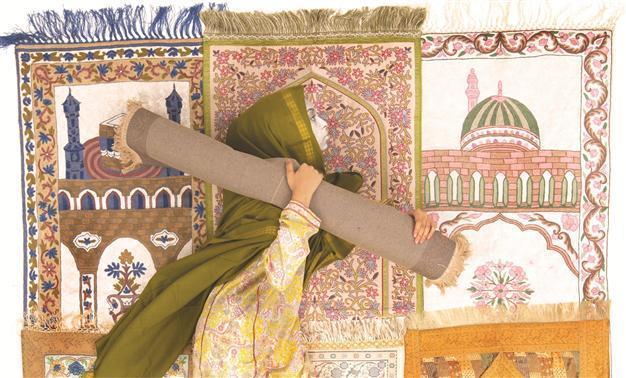Middle Eastern art exhibition links process to content
ISTANBUL - Hürriyet Daily News

AFRA BIN DHAHER. Exhibition captures a major aspect of Middle Eastern art, which takes its shape from traditional patterns and integration
of cultural motifs with Western art forms.
A fine blend of global and local motifs is definitely characteristic of what is far too generally called “Middle Eastern art,” and is one reason the art of the region tends to attract widespread recognition and admiration. A selection showcasing this unique style is currently on display at Istanbul’s Galeri Zilberman, in a show titled “Tessellation Make Up.” Selected by Canadian curator Janet Belotto, the show pulls together work by about 30 artists born or based in different parts of the region.
“Tessellation ... refers clearly to two things. First, it points at a repetition of the same pattern, and secondly, it points at putting two patterns side by side to create an overall image. In that sense, it refers to making art but also to the nature of art curation; every curation is a tessellation in a way,” Belotto said, explaining her choice of theme. “The first time I came up with the idea of tessellation, I wanted to look into new trends and what is developing on the Dubai art scene. I have been in Dubai for six years now and I am teaching in a university art program, so I am quite active in the scene.

TARAVAT TALEPASAND
Basically, what I have been seeing as a common attribute in the art production in the region is an attempt to create imagery or recreate memories in order to come up with a critical look at social and political history.”
This case is perhaps best exemplified in the Zilberman show by two photographs by Iraqi artist Al Fadhil.
“I work on history because my people’s memory of it lasts too short a time. These two photographs ‘Portrait of the Unknown Soldier’ and ‘Pipeline Landscape’ are newspaper images documenting the Iraq-Iran War,” Al Fadhil said. The artist describes the series as an “Iraq-Iran War Archive,”
“These photographs show Iraqi soldiers within the Iranian border. ‘Pipeline Landscape’ shows an oil pipeline being bombed in the background, but what strikes me most about this photograph is the expression on the soldiers’ faces. The green-uniformed soldiers are Special Forces. The other two on the right end are ordinary soldiers, and the one in the middle is a volunteer. The other four know very well what it means to be in a war, hence the anxiety on their faces. The one in the middle, on the other hand, is posing with the broadest smile on his face and signing ‘triumph’ with the gesture of his hand, because he has no idea what he has thrown himself into,” Al Fadhil said.
Middle Eastern artThe exhibition successfully captures a major aspect of Middle Eastern art, which takes its shape from

AL FADHIL
recurring traditional patterns and the integration of cultural motifs with Western art forms.
“This is because [Middle Eastern artists] identify with their culture so much. Modern art is too much influenced by Western culture, and for the sake of opening space for their own identity Middle Eastern artists are establishing within it something they can relate to. This is a way of establishing a dialogue between two cultures, and it is not only about transforming a Western medium into a more familiar space, but it also is about turning it into a personal space. I think that engagement is their main inspiration,” Belotto said.
Belotto also pointed out another aspect of Middle Eastern art that influenced her greatly while curating the show. “There is this layering in their processes. Just like the way one weaves some colorful fabric, which applies best perhaps to Mathia Demithan’s ‘Still Waters,’ for which she uses hundreds and hundreds of tiled body scans.” Belotto also took part in the making of this work as its model.
Another example of this layering or weaving, which correlates with the overall theme of tessellation, can be seen in Sadegh Tirafkan’s “Human Tapestry” series, two works from which are included in the selection at Zilberman. The works imitate traditional carpet designs. “Every carpet has a different design due to the weaving materials. The one with the three rhombi in the middle area has the typical design of a silk carpet. In silk-woven carpets you may have more minute details compared to other materials,” Tirafkan said.

ILGIN SEYMEN
Millions of threadsThe works are built up from the multiplication of the same crowd image in various sizes and filters. The rhombi are made up of photographs of people the artist personally knows, as well as self-portraits.
The analogy the work draws upon is quite obvious. “Just like the fact that a carpet is made up of millions of threads, it takes millions of people to make one nation,” Tirafkan said, adding that his chief inquiry is into how a population relates to their culture. But the work is also a metaphor for the fact the way cultures shape or reshape populations.
The only Turkish artist included in the show is Ilgın Seymen, who is represented by her collage works “28 Fragments,” and “Terra Incognita.” Both pieces are made using same technique of paper collage with labels from multinational corporations. The overall images are reminiscent of world maps.
Seymen’s work, therefore, concretizes the concept of tessellation in its diversity of meaning. “Tessellation Make Up” runs through Oct. 20.



